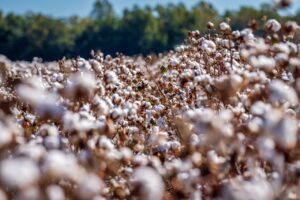Why do we need to track cotton?[1]
Cotton is one of the most widely used natural fibers in the world, used in a variety of products, including apparel, bedding, towels, and industrial materials. However, the cotton supply chain is complex, with many intermediaries involved in the supply chain, from farmers to textile manufacturers to retailers. With so many actors involved, it can be challenging to trace the origins of cotton and ensure that it is produced in a sustainable and ethical manner.

Tracking for Transparency
The need to track cotton comes from a variety of factors. First, consumers are increasingly demanding transparency and accountability from the companies that produce the products they buy. Consumers want to know where their cotton comes from and whether it was produced in an environmentally and socially responsible way. If you pay a premium for organically grown Egyptian cotton, you want to know that you’re getting exactly the product that you paid for. Without a way to track cotton, it is impossible to provide this level of transparency and accountability.
Ensuring Sustainability
Another reason why tracking cotton is important is to ensure that it is produced in a sustainable way. Cotton production can be very resource-intensive, using large amounts of water, fertilizers, and pesticides. This can have negative environmental impacts such as soil degradation and water pollution. By tracking cotton, companies can identify areas where sustainability practices can be improved by working with farmers.
Promoting Ethical Practices
Tracking cotton also helps to ensure that it is produced in an ethical manner. Cotton production can be associated with labor rights violations, including child labor and forced labor. New laws in the U.S. require that businesses prove their imported goods were produced without forced labor or be seized at the border. U.S. customs officials estimated that by March 2023, they had already stopped a billion dollars worth of goods that were suspected of having ties to Xinjiang, China, a region whose products have been banned since June 2022 due to widespread use of forced labor. By tracking cotton, companies can identify potential risks and work with suppliers to address these issues.
DNA Tracing
One technology that is used to track cotton is DNA tracing. DNA tracing has several advantages over traditional tracking methods. First, it is more accurate than traditional tracking methods, which rely on paper or computer records that can be lost or falsified. Second, it is faster than traditional tracking methods, allowing companies to quickly identify the origin of cotton fibers. Finally, DNA tracing can help to prevent fraud, as it is difficult to counterfeit DNA markers.
Applied DNA Sciences is one company that uses DNA technology to allow companies to inspect their supply chains. One method involves spraying DNA mist onto cotton. Testing for the specific DNA that was put onto the cotton allows the business to trace where their goods have been throughout the manufacturing process. In addition, Applied DNA and sequence the DNA of the cotton itself to determine where it came from. Differences in soil, temperature, rain, and other growing conditions al mean that there are slight variations in cotton that is grown in different places around the world and DNA testing reveals those differences.
This is just one example of technology that is used to track complex supply chains. Other companies also use blockchain and artificial intelligence. As supply chains get more complicated, these new technologies are necessary to ensure transparency and accountability.
- Adapted from Swanson, Ana. “How A.I. and DNA Are Unlocking the Mysteries of Global Supply Chains.” New York Times, April 7, 2023. https://www.nytimes.com/2023/04/07/business/economy/ai-tech-dna-supply-chain.html. ↵